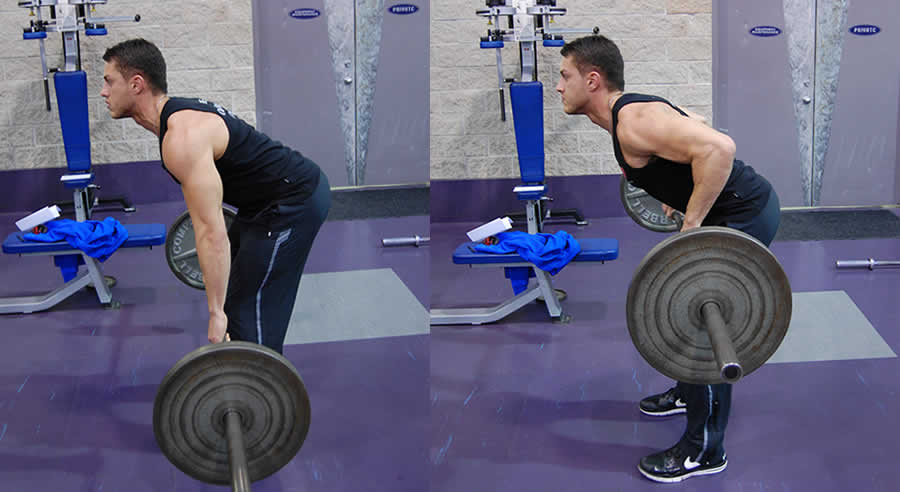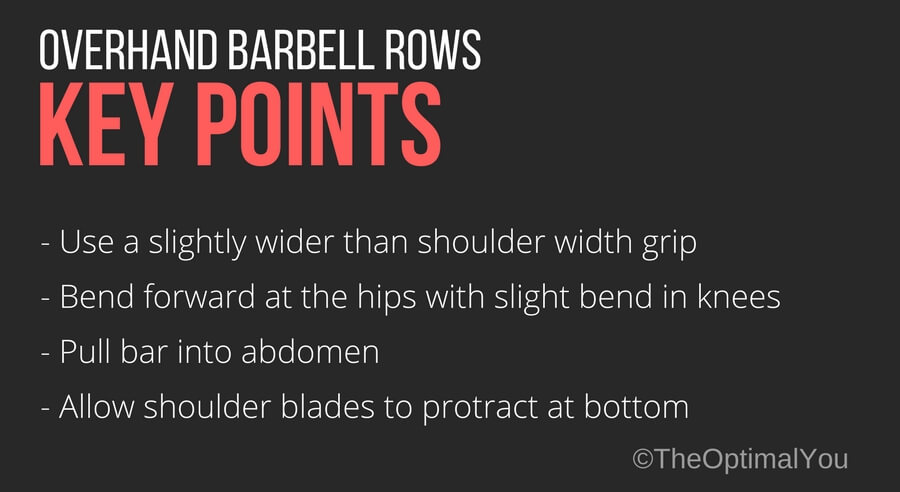Purpose of The Overhand Barbell Row
The overhand barbell row is one of three primary row variations performed with a barbell – the other two being the underhand barbell row, and t-bar row.
The overhand barbell row is designed to target the musculature of the back, and additional emphasis can be placed on some regions at the expense of others depending on how you do it.
Equipment Needed For Overhand Barbell Rows
As you can imagine, the only piece of equipment required to perform an overhand barbell row is a barbell.
Difficulty of Overhand Barbell Rows
On a scale of 1 to 5, overhand barbell rows would rank around a 4, as they require greater levels of coordination, and concentration, than machine/cable based rowing exercises, due to the increased demand on the lower back and core to provide the stability necessary to perform the exercise correctly.
How to do Overhand Barbell Rows
To perform overhand barbell rows, grab onto a bar with a slightly wider than shoulder-width grip, and bend forward at the hip until the torso is parallel with the floor while maintaining an arched back, and a slight bend in the knee.
Allow your shoulders to protract, but make sure not to round excessively through the back. From this position, pull the bar into the abdomen while keeping the elbows as tight to the body as possible.
Beginners may want to pause at the top with the bar touching the midsection as a way of gauging what the top position should feel like, but after the beginning stages it’s no longer necessary to do this as it quickly fatigues the smaller, weaker, biceps and forearm muscles, which negatively affects subsequent performance.
After the bar makes contact with the abdomen, lower it under control back to the starting position, making sure to allow the shoulder blades to protract – this stretches the primary muscles involved, and the muscles that are stretch the most, are recruited the most.
Key Points When Performing Overhand Barbell Rows
- Use a slightly wider than shoulder-width overhand grip
- Bend forward at the hips with a slight bend in the knee until the torso is parallel with the floor
- Pull the bar into the abdomen while keeping the elbows tight to the body
- Allow the shoulder blades to protract at the bottom to ensure the primary muscle groups are stretch to the best of their capacity so they can be recruited to the best of their capacity
How Many Reps When Performing Overhand Barbell Rows
Because the lower back is under constant tension just to provide stability to allow barbell rows to be performed, irrespective of whether you are using and overhand or underhand grip, it can often become a limiting factor the longer a set goes on.
It is for this reason that barbell rows of any kind are best limited to 10-15 reps – if the weight is too heavy, and you can’t perform 10 reps, it promotes cheating by generating momentum with the hips which reduces muscle activity in the muscles in the back that you likely wanted to target when you selected a barbell row variation in the first place.
On the flip side, if the weight is too light the lats may not be recruited, and other smaller muscles like the biceps can easily take over. The weight should be heavy enough that the lats need to be recruited, but light enough that you don’t feel the need to generate momentum just to get the weight up.
Common Mistakes When Performing Overhand Barbell Rows
Some of the more common mistakes when performing overhand barbell rows are:
Going too heavy – if the weight is too heavy you can easily find yourself generating momentum to initiate the movement, reducing the demand on the desired muscles you wished to train when choosing barbell row variations in the first place.
Keeping the shoulders pinned back throughout the movement – one of the absolute worst cues trainers give clients when performing back exercises is to “keep their shoulders down and back.” The muscle that is stretched the most is generally recruited most, and keeping your shoulders pinned back limits the primary muscles involved in barbell row variations from doing the job they’re designed to do.
Standing upright – to compensate for using too much weight, many people will perform this exercise by standing almost fully upright and barely pulling the bar above the waist. This is nothing but ego lifting, and will do nearly nothing for developing any of the major muscles on the back.
Modifications to The Overhand Barbell Row
The reason it is suggested to keep the elbows tight to the body is because that is the plane of motion that the lats are most responsible for. If you wanted to target more of the mid-back (rhomboids, traps), or rear delts, then you could take an ever wider grip, and flare your elbows out to the side as you row. Instead of pulling to the abdomen, you would pull closer to the chest in this case.
When to do Overhand Barbell Rows
Overhand barbell rows are a “bread and butter” type of movement for the back. Not only are the lats targeted, but the mid-back, and lower back also take a beating because these muscles have to work to produce force, and also provide stability.
Because stability is such a huge component when performing any type of barbell row, doing them at the end of a workout in a fatigued state may not be optimal for anyone except the most advanced lifters. It’s for these reasons that they should generally be placed either first, or second, in a workout.
Alternatives to Overhand Barbell Rows
Any rowing variation can be used as an alternative, but for those who have a bad back a variation in which the upper body is supported is preferred. In this case a chest-supported machine row would allow you to safely target the same regions without the added risk that stabilizing your body in space while holding onto a loaded barbell comes with.
Overhand Barbell Rows vs. Machine Rows
The primary difference, as stated above, is that with the overhand barbell row you must use the muscles of your back and core to stabilize your torso when performing the exercise, while when using a chest-supported machine you do not need to worry about creating stability, as the machine does that for you. By removing the stability component, the individual can better focus on directing stress through their intention onto the desired muscle groups.
Overhand Barbell Rows vs. Underhand Barbell Rows
Overhand barbell rows and the underhand barbell rows both target the lats but underhand barbell rows place greater emphasis on the lower portion lats, whereas overhand barbell rows place greater emphasis on the upper portion of the lats. Underhand barbell rows also engage the biceps to a greater degree.



